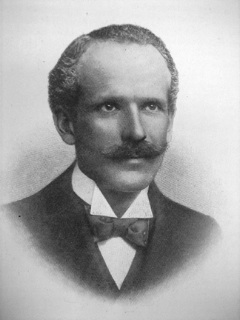Carl Hentschel
(1864 – 1930)
Carl Hentschel was a key figure in the new era in visual representation that came into being during the 1890s. Born in Lodz, Poland, in March 1864, Hentschel arrived in England with his parents at the age of five. His father, August Hentschel, professed to have worked with Louis Daguerre (1787-1851) and trained his son in a number of reproduction techniques that August had devised. In 1887, at the age of twenty-three, the young man set up his own business, Carl Hentschel and Company, specializing in line reproduction of pen-and-ink illustrations through a combination of mechanical and manual techniques. The blocks produced by the new photomechanical techniques required considerable adjustment and retouching by hand. The services of an experienced process house and a knowledgeable art editor were therefore important. For instance, Hentschel worked closely with Joseph Pennell (1857-1926) on his experiments in reproducing illustrations for the daily press.
Carl Hentschel and Company became the largest reproduction firm in England and claimed to be the largest in the world. The firm adopted the latest technologies and business methods, including electric lighting, telephones, an extensive clerical organization, and an active sales force. By 1894, Hentschel’s staff of seventy was based in three “factories” in Fleet Street, turning out 60, 000 blocks per year. The Company produced engravings for newspapers, periodicals, and books, with important clients including large publishing firms like Cassells and artistic magazines like The Yellow Book . Carl Hentschel was also active in attempts to regulate the process industry.
Hentschel was an energetic businessman at the centre of a network of connections between printing, journalism, image making, and the modern city. He was an obsessive theatregoer who co-founded the Playgoer’s Club in 1883 and claimed to have rarely missed a West End first night. While Hentschel’s firm was working on the line images for The Yellow Book, art-editor Aubrey Beardsley, (1872-1898) another theatre devotee, designed the menu for the Playgoer’s Club Annual Dinner held at the Criterion Restaurant in January 1894. Unlike most middle-class businessmen, who aspired to a country house, Hentschel preferred to live in central London. His artistically decorated home in Chancery Lane was near his workshops, with the West End theatres only a short walk or cab ride away. Hentschel’s friend, the editor and writer Jerome K. Jerome (1859-1927), used him as the basis for the character Harris in his comic novels Three Men in a Boat (1890) and Three Men on the Bummel (1900). The fictional Harris’s enthusiasms recall the cycling competitions and social events organized by Hentschel and Co.
© 2010, Gerry Beegan
Gerry Beegan is an Associate Professor at Mason Gross School of the Arts, Rutgers University, where he teaches design and design history. His research and curatorial interests center on the printed image. Beegan’s writings on the history and theory of reproduction have been published internationally in journals and magazines including Design and Culture, Journal of Design History, Design Issues, Journal of Visual Culture, and dot dot dot. His book, The Mass Image: A Social History of Photomechanical Reproduction in Victorian London, is published by Palgrave Macmillan.
Selected Publications by Hentschel
- “A Process Autobiography.” Process Photogram 12.143 (November 1905): 174-175.
- Process Engraver. London: G. Philip & Son, [1910].
- “Process Engraving.” Journal of the Society of Arts 49.2474 (April 20 1900): 463-474.
Selected Publications about Hentschel
- Anon. “Our Portrait Gallery: Messrs. Carl Hentschel & Co.” British Printer 8.45 (May- June 1895): 137-142.
- Anon. “A Notable Process Engraver – Mr. Carl Hentschel.” Printing World 5.6 (June 1897): 132-133.
- Anon. “Pictorial Reproduction Up-To-Date: Carl Hentschel, Ltd., London.” British Printer 13.77 (September 1900): 223-31.
- Anon. “Commercial Marvels of Photography: The Illustration Process.” Photogram 13.147 (March 1906): 85-88.
- Anon. “Mr. Carl Hentschel.” The Times 45407 (Jan. 10, 1930): 14.
- Jerome, Jerome K. My Life and Times. London: Harper Brothers, 1926.
- Pennell, Joseph. “A New Illustrator.” Studio 1.1 (April 1893): 14-18.
MLA citation:
Beegan, Gerry. “Carl Hentschel (1864-1930),” Y90s Biographies, 2010. Yellow Nineties 2.0, edited by Lorraine Janzen Kooistra, Ryerson University Centre for Digital Humanities, 2019, https://1890s.ca/hentschel_bio/.
